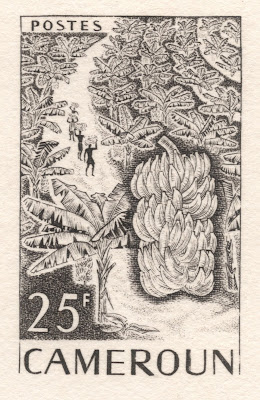Claude Robert Ernest Durrens was born on August 22,
1921 in Cenon, a suburb of Bordeaux, France. His family may have been involved
in architecture, but when the young Claude entered the School of Fine Arts in
Toulouse, he chose the direction of painting and decoration. What had attracted
him to art was the notion that the hand is the tool of the mind, and that holds
true for whatever material you’re working with. His teacher recognised his
talents and guided him towards the art of engraving. This turned out to be a
smart move for Durrens left school in 1940 with a first prize in engraving.
After the Second World War, Durrens continued his
studies in Bordeaux for another two years, where he also received first prize,
which came with a grant for a three years’ course at the Academy of Fine Arts
in Paris. There he entered the engraving class of the famous stamp engraver
Robert Cami. In 1952, Durrens won the coveted Prix de Rome. This allowed him to
stay there at the Villa Medici for three years, emerging himself in the world
of art, while also getting married to fellow artist Janine.
Returning home, the couple soon became well known
figures in the French art world, with Claude Durrens gaining recognition for
his wood engravings. In 1958, he got the chance to design and engrave his first
stamps. Issued in 1959, they were the two ‘Bananas’ stamps issued in Cameroun.
These, incidentally, were the last stamps issued in Cameroun before becoming an
independent republic.
Normally, French engravers had to wait for a good
number of years before being allowed to start working on French stamps, but
Durrens got his first French stamp assignment in 1959, when he was asked to
engrave a design by Jacques Combet, depicting an oil derrick and pipeline at Hassi-Messaoud
in the Sahara, part of a set marking French technical achievements.
A fine career spanning several decades followed,
during which Durrens received the Grand Prix de l’Art Philatélique several
times for French stamps he both designed and engraved: in 1961 for his stamp
portraying father Lacordaire, in 1965 for his Joux Castle stamp and in 1966 for
his rendition of De La Tour’s New-Born Child. Durrens also received the prize
for two stamps he engraved but did not design: in 1971 for the Barque
Antoinette stamp, and in 1972 for the Grand Banks Fishing Barquentine Côte
d’Emeraude.
Durrens’ award-winning 1966 De La Tour stamp was
used on a souvenir sheetlet produced for the French Postal Museum. The sheetlet
showed the various printing stages of a multi-coloured recess-printed stamp,
with prints of the two dies that need to be engraved for such stamps. One die
for the actual design, printed in recess, and the other for the background
colours, printed in indirect recess. The difference being that with direct
recess, the printing cylinder gets inked and will transfer that ink straight
onto the paper, whereas with indirect recess, the inked printing cylinder will
transfer the ink to a maximum of three colour cylinders which in their turn
transfer the ink to the stamp paper.
He did get to design and engrave a few rather
remarkable Tourism stamps though. While these are normally quite realistically
depicted scenes, Durrens created two very different ones: a stamp from 1974
depicting Salers and one from 1980 depicting Cordes. Both stamps are more of a
stylistic interpretation of these towns, and through a sparse colour
distribution of his engravings, Durrens managed to perfectly capture the
uniqueness of these places.
Durrens’ involvement in creating various Marianne
definitives for France was rather intense, although it never led to his own
essays being adopted. In 1967, an old design by Henry Cheffer, once rejected, was
dusted off and declared rather suitable. Unfortunately, Cheffer had passed away
by then so Claude Durrens was asked to engrave the design. During this stage he
did also submit some ten designs of his own, which never reached the engraving
state unfortunately. The Marianne de Cheffer proved so popular that it received
the Grand Prix de l’Art Philatélique in 1967; the only time a small format
definitive has won that prize.
In 1975, Durrens again submitted a design for a
Marianne definitive. Proof printings were made in May 1975 but the project was
later abandoned. One sheet of 100 stamps ended up in private hands but that has
since been split up and the stamps appear in auctions every now and then.
They did, once again, ask Durrens to engrave the
Marianne design that had been chosen.
Durrens was subjected to very strict guidelines by the designer Roger Excoffon.
A die proof turned out alright, but when the stamp went into production, it
turned out that the engraving was too fine and the plates would wear within a
day. So a deeper engraved die was made but this led to a worse printing quality
and the superb finesse of the portrait was lost. The French printers had to
give up and a different design was chosen instead, this being Gandon’s Sabine,
engraved by the designer himself.
Undeterred, Durrens submitted yet another Marianne engraving in 1989, of a design by De la Pattelière, which eventually was not adopted. The engraving would
be used for one of the ‘philatelic documents’ which accompany most French
issues.
Durrens also engraved the odd banknote. In 1968, two
of his engravings appeared on banknotes of France: a portrait of Charles de
Secondat on the 200f banknote and a portrait of Blaise Pascal on the 500f
banknote.
Some 400 French stamps later, Durrens retired in
1997. He was not to enjoy his retirement too long, unfortunately, for he passed
away on 20 December 2002, in Bordeaux, France.
You will find Claude Durrens’ database HERE.






